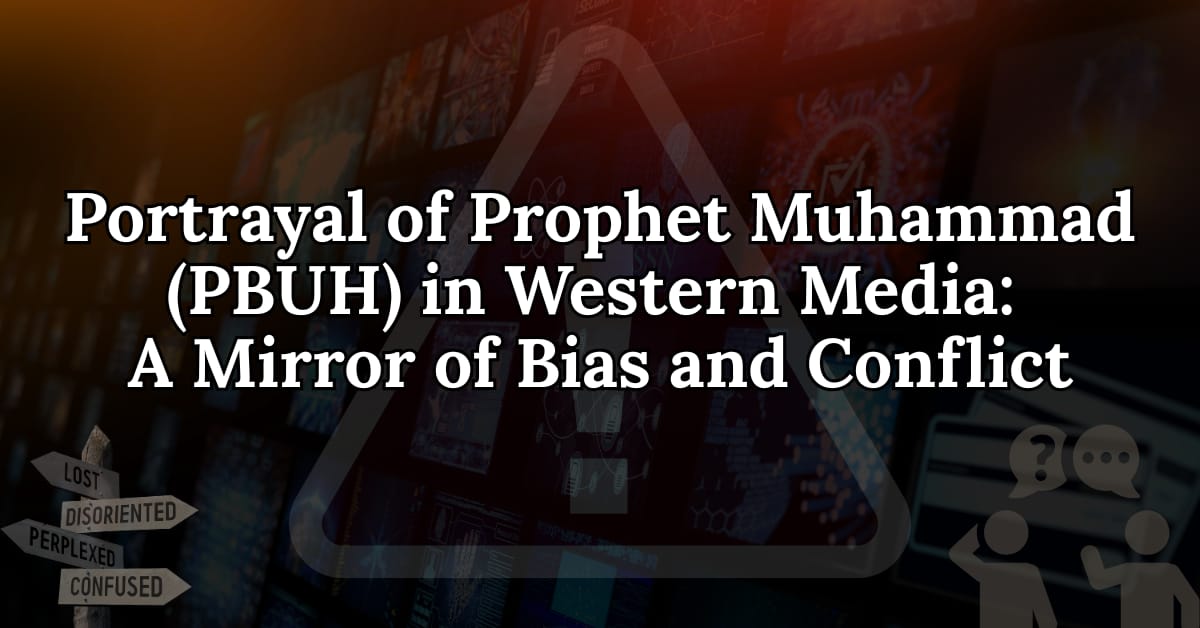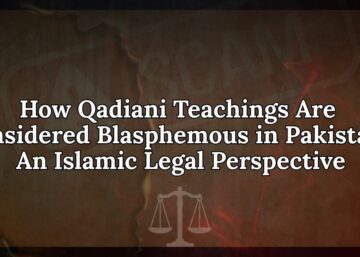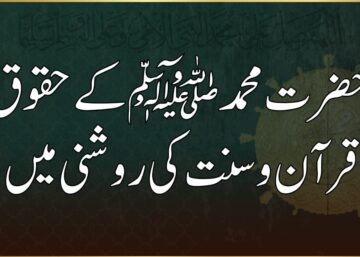A Mirror of Bias and Conflict
In a world more interconnected than ever, images both literal and metaphorical, carry enormous power. How a culture portrays another’s sacred figures reveals a great deal: about fear, misunderstanding, projection, and, also about who gets to tell the story. The Prophet Muhammad (PBUH) has been among the most persistent figures in contested narratives between Islam and the West. He (PBUH) is not merely a religious figure; in Western discourse he has become a symbol of reform, resistance, threat, or caricature. In Western media, depictions of Prophet Muhammad (PBUH) frequently carry harmful consequences, eroding the trust of Muslim communities in both the media and the societies they reflect. Cartoons, films, and social media portrayals that visually represent the Prophet are viewed as deeply offensive, since Islam strictly forbids such images to prevent disrespect and idolatry. For Muslims, these incidents are rarely seen as isolated acts; rather, they are perceived as part of a broader, hostile narrative that misrepresents Islam and unfairly defames its followers, intensifying feelings of emotional hurt, alienation, and mistrust within Muslim communities living in the West. This article explores how the Prophet Muhammad (PBUH) is drawn in Western media (historically and today), what this says about Islamophobia, and what might be done to break out of the cycle of provocation and resentment.
Western Frameworks: Orientalism and the Invention of a Threat
Orientalism as intellectual infrastructure: Western knowledge about Islam and Muslims has, since the Crusades, often been shaped by a lens that assumes a civilizational hierarchy with the Christian/Western above “Orient”/Islamic. Orientalism does not just misrepresent; it constructs Islam and its Prophet as the “Other” against which the West defines itself. Scholars point out how this makes negative portrayals seem “natural” rather than ideologically loaded.
Sirah literature and polemic: In Western Sirah writing (biographical accounts of the Prophet Muhammad (PBUH)), there has long been a mixture of hostility, exaggeration, and missionary agenda. These texts often served religious, political, or colonial purposes. Biases in sources, misinterpretation, and the use of mythology or hearsay have influenced these portrayals.
Projection of fears: Often what is projected onto Islam and on Muhammad (PBUH) is not evidence about Islam itself but anxieties about political power, immigration, identity, secularism vs. religion, or social change. Muhammad becomes not merely a historical figure but a symbol for “what the West fears”—fanaticism, authoritarianism, moral backwardness, etc.
Historical and Literary Examples of Negative Portrayals
Medieval Europe and fantasy of the “Mahound.” During the Middle Ages, Muhammad was frequently misnamed “Mahound,” demonized in Christian epics as a false idol, a pagan magus, or a trickster. These narratives often attributed immoral behavior or deceit to Him, creating a caricatural “other.”
Renaissance, Reformation and Enlightenment shifts. As Europe gradually moved toward modernity, some writers continued hostile depictions; while others began to portray Prophet Muhammad (PBUH) in more complex terms as a reformer, lawgiver, or cultural civilizer though often still through a distorted lens. John Tolan’s Faces of Muhammad explores how even “positive” portrayals were framed in comparison to Christian norms.
Colonial era and missionary literature. The period of colonial expansion, there was an increased production of literature that sought to justify Western domination by representing Islam as backward, fanatic, and superstitious. Prophet Muhammad’s (PBUH) image was often used symbolically to represent what colonizers claimed were centuries of stagnation, violence, or tyranny in Muslim societies. These narratives often ignored or minimized internal diversity, reform movements, and the historical contributions of Islamic civilization.
Contemporary Media and Caricature: Cartoons, Satire, and Provocation
Several high-profile incidents in the West targeting Prophet Muhammad (PBUH) have triggered widespread protests and deepened tensions between Muslim communities and Western societies. One of the earliest was the Danish Cartoons Controversy of 2005, when the newspaper Jyllands-Posten published twelve caricatures of the Prophet, which many muslims found deeply offensive. The publication sparked global outrage, leading to mass protests, boycotts of Danish goods, and violent demonstrations across several Muslim-majority countries throughout 2005 and 2006. A few years later, in 2012, the release of the amateur U.S.-produced film The Innocence of Muslims, which portrayed the Prophet in a derogatory manner, ignited another wave of anger. This film provoked large-scale protests in multiple countries, including Egypt, Libya, and Pakistan, some of which escalated into deadly violence and attacks on Western diplomatic missions, intensifying anti-Western sentiment across the Muslim world.
In 2015, the French satirical magazine Charlie Hebdo once again inflamed Muslim sensitivities by publishing cartoons of the Prophet Muhammad (PBUH). The publications prompted mass protests in several Muslim countries, notably Pakistan, where demonstrators clashed with police near French diplomatic offices. Earlier depictions by the magazine had already made it a target, culminating in a deadly terrorist attack on its Paris headquarters in January 2015. These incidents collectively illustrate how offensive portrayals of the Prophet in Western outlets not only wound Muslim religious sentiments but also ignite widespread unrest, creating cycles of mistrust, conflict, and polarization between Muslim communities and the West.
Cartoon controversies: The Danish newspaper Jyllands-Posten in 2005 published caricatures of Prophet Muhammad (PBUH) that provoked global outrage. These images often fused religious iconography with terrorism tropes, bomb, turban, etc. evoking associations of Islam with violence. Similar controversies followed in other European countries. These episodes highlight not only issues surrounding freedom of expression but also historical baggage and inequities who is permitted to offend who is silenced, and who suffers consequences.
Satire and media production: Magazines such as Charlie Hebdo have repeatedly pushed boundaries, sometimes under the justification of satire, secular critique, or free speech. But for many Muslim communities, these satirical works are not read as nuanced critique but as hurtful mockery that recycles old tropes: that Prophet Muhammad (PBUH) is irrational, violent, backward, or hypocritical.
Films, documentaries, popular culture: Western media often depict Muslims through the frames of extremism, terrorism, or civilizational conflict. There are few representations of Muhammad that align with Muslim sensibilities (for example, those that avoid depicting his face or person physically). Attempts to show peaceful or spiritual aspects are rarer, or tend to be mediated through a secular or Western lens.
Effects and Consequences: Beyond Offense
Harm to interfaith relations and trust: Negative portrayals deepen divisions. For many Muslims, recurring insults or caricatures feel like collective violence (symbolic but deeply hurtful). They amplify distrust of Western media, culture, or institutions, often reinforcing isolation or defensive identity politics.
Domestic consequences: prejudice, discrimination, policy: Islamophobic media portrayals are not merely abstract; they influence public opinion, political discourse, and policy. Studies show that “security framing” of Muslims portraying them as potential threats which leads to discrimination in law enforcement, immigration, social integration, and beyond.
Radicalization cycles: Provocative depictions sometimes generate strong reactions, protest, outrage, and in extreme cases violence. These responses are then used to justify further negative portrayals, feeding a feedback loop. Each side can use the other’s actions as evidence for its own narrative of victimhood or hostility.
Complexity: Nuance, Positive Portrayals, and Shifting Narratives
Not all Western portrayals are negative: As John Tolan and others show, Muhammad has sometimes been represented in the West as visionary, leader, lawgiver especially in more recent centuries. These portrayals reflect certain biases or be filtered through Western frameworks, but they offer a counterbalance to purely hostile images.
Revisionism, scholarship, and empathy: More recent academic work and popular writing is increasingly trying to foreground Muslim voices, to correct historical distortions, and to understand Muhammad in his historical, cultural, and religious context not just as “the Other.” Some Western authors and scholars attempt to disassemble tropes.
Media self-critique and controversies: Some Western media outlets have been challenged internally or publicly either for publishing insensitive depictions or for under-representing Muslim perspectives. Debates over free speech vs responsibility, satire vs hate speech, are more visible than before.
Challenges: Where Understanding Fails
Asymmetry in consequences: In many Western societies, offensive portrayal comes with limited risk: a lawsuit, public backlash, maybe reputational loss. For many Muslims, the consequences include real danger: hate crimes, social exclusion, violence, or political marginalization. This asymmetry deepens resentment and stays largely unaddressed in many mainstream discourses.
Simplified narratives: Western media often reduces Islam and, by extension, Islamism to a limited set of tropes: terrorism, misogyny, extremism. Such simplifications erase diversity of theology, culture, politics and leave no space for complexity or self-critique. Prophet Muhammad’s (PBUH) life, which encompasses spiritual, moral, political, social dimensions, gets flattened or ignored except where it can support sensational narratives.
Cultural disrespect as political tool: Sometimes, provocations are used deliberately to assert secularist, nationalist, or liberal values (or to test boundaries), even when they hurt religious minorities. There is a question: do these acts challenge power or consolidate it? Often the latter, when religious minorities are marginalized already.
Conclusion
The way the Prophet Muhammad (PBUH) depicted in Western media is not merely about pictures or cartoons. It is about power who controls narrative, who gets to offend, who is made vulnerable. It is the lodestone of larger questions: identity, supremacy, fear of the other, religious liberty, and mutual respect.
Hostile portrayals are not simply accidents of ignorance; in many cases they are the outcome of longstanding ideological, political, and social forces colonial legacies, Orientalism, secular‐religious conflict, and media economies that favor provocation.
The path forward requires more than demanding for “respect.” It requires real shifts: in education (so people know history and theology better), in media practice, by giving muslims greater voice and agency in public through stronger protections for minorities against hate; and in personal moral imagination (seeing the sacred symbols of others with empathy, not merely as objects for satire).
References:
- Faces of Muhammad: Western Perceptions of the Prophet of Islam from the Middle Ages to Today by John Tolan.
- “Orientalism as a Cultural Root of Western Islamophobia.” UMT Journals
- “The Offensive Depictions of Prophet Muhammad (SAW) in Western Media and its Consequences.” UMT Journals
- Studies on media framing of Islam and Muslims in the West.



